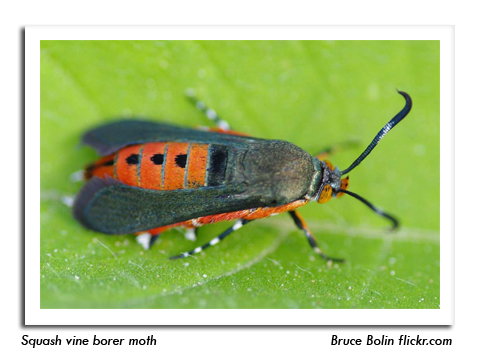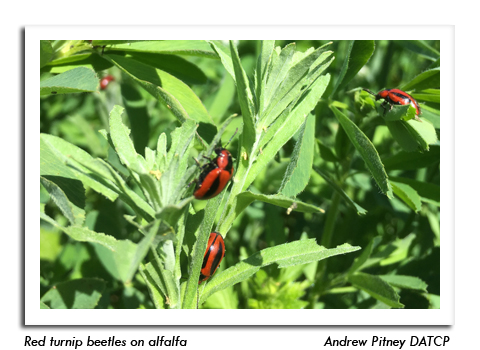
 |
|
|
Vegetables
Volume 62 Number 9 Date 06/22/2017 SQUASH VINE BORER - Moths have been observed around winter squash and cucumbers in Grant and La Crosse counties since June 9. Growers of vine crops should begin checking plants for the flat, brown eggs deposited at the base of stems as soon as the moths are noticed. Control is required immediately after the eggs are found to prevent the larvae from boring into the vines. Gardeners may remove the eggs by scraping them off with a fingernail. Covering plants with row covers or netting to prevent egg deposition and placing yellow pheromone-baited sticky traps around plantings may also help to reduce SVB problems. A conventional insecticide or kaolin clay applied to the plant bases as a weekly spray during the three- or four-week egg laying period can provide protection if the sprays thoroughly cover the plant stems and are applied repeatedly to assure good control. IMPORTED CABBAGEWORM - Damage caused by larger cabbageworms has become very conspicuous, making the velvety green caterpillars generally easy to find and remove from gardens and smaller plantings. For larger commercial cabbage crops where chemical control may be required, ICW populations should be assessed weekly by examining 25-50 randomly-selected plants (depending on field size) and recording the number of infested plants. A plant is infested if eggs or caterpillars are found. Control decisions should be made based on a threshold of 30% infestation in the transplant to cupping stages; 20% infestation from the cupping to early head stages; and 10% from early heading until harvest. For broccoli and cauliflower between transplant and first flower or curd, the threshold is 50%, decreasing to 10% once flowers or curds begin to develop to maintain quality. POTATO LEAFHOPPER - A significant migration occurred about two weeks ago and alfalfa surveys indicate adult populations are now above-threshold (two per sweep) in a few western Wisconsin fields. Nymph production has also begun, and the combination of immature leafhoppers and harvesting of second-crop alfalfa could cause an abrupt increase in leafhoppers in snap beans, potatoes and other vegetable crops by July. Sampling should be increased at this time. A threshold of one nymph per 10 leaves or one adult per sweep is specified by the UW to determine if control is justified in snap beans. The threshold for potatoes is 2.5 nymphs per 25 leaves or 0.5-1.0 adult per sweep. RED TURNIP BEETLE - This red and black beetle was noted in exceptionally high numbers in Waushara County alfalfa earlier this month, and a report of damage to cole crops in a garden near Wautoma was received last week. Red turnip beetle is an occasional pest in the Central Sands area of the state that could become a problem in more home gardens since populations appear to be higher than normal this summer. Hosts include broccoli, cabbage, kohlrabi, radish and turnip, but hoary alyssum and yellow rocket are thought to be the primary food plants. Small seedlings and transplants are the most susceptible to red turnip beetle feeding, while established plants can tolerate severe defoliation. Removing the adult beetles by hand is the recommended control. Beetle numbers usually begin to decline by late June or July. -- Krista Hamilton, DATCP Entomologist 





|
|
|